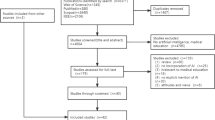Abstract
Background
In the current era of medical teaching, multiple active teaching-learning strategies are being explored due to drawbacks of conventional didactic learning methodology which are applicable to a typical classroom setting. Our attempt was to introduce short interactive buzz sessions in the midst of a lecture and assess the perception of students and faculty towards the use of these buzz sessions as an active learning method in physiology.
Aim and Objectives
To introduce buzz sessions as a teaching-learning tool in undergraduate medical teaching and to assess the student and faculty perception of this teaching method.
Methodology
This prospective, non-randomized, interventional study was carried out in the Department of Physiology, GMC Srinagar. The participants were 180 students of MBBS 1st Phase and 08 faculty members of the Physiology Department. Both the students and faculty were sensitized about the buzz sessions. Ten lectures of 1 h each were chosen from the Endocrine System, and taught by incorporating the buzz session in the lecture. The study was approved by the Institutional Ethical Committee.
Results
Both the students and the faculty favoured incorporating buzz sessions during the lectures as this teaching method makes the class interesting and interactive and helps to enhance communication, reasoning skills, and collaborative learning among the students.
Conclusions
The study concludes that learning physiology using buzz sessions is liked and preferred by both students and faculty, and hence the need for buzz sessions in current medical teaching.
Similar content being viewed by others
Data Availability
All data supporting the findings of this study are available within the paper.
References
Park JC, Kwon HE, Chung CW. Innovative digital tools for new trends in teaching and assessment methods in medical and dental education. J Educ Eval Health Prof. 2021;18:13.
Gary LA, John CP, William BW, Jeff CF, Richard WS, Dale AS. Using “active learning” methods to teach physiology. J Int Assoc Med Sci Educ. 2014;21(1):8–20.
Prober CG, Heath C. Lecture halls without lectures - A proposal for medical education. NEngl JMed. 2012;366:1657–9.
Steinert Y, Snell L. Interactive lecturing: strategies for increasing participation in large group presentations. Med Teach. 1999;21(1):37–42.
Papanna KM, Kulkarni V, Tanvi D, Lakshmi V, Kriti L, Unnikrishnan B, Akash S, Tejesh S, Sumit Kumar S. Perceptions and preferences of medical students regarding teaching methods in a Medical College, Mangalore India. Afr Health Sci. 2013;13(3):808–13.
Ismail S, Rahman NI, Mohamad N, Jusoh NM, Hood AI, Arif LA, et al. Preference of teaching and learning methods in a new medical school of Malaysia. J Appl Pharm Sci. 2014;4:48–55.
Cantillon P. ABC of learning and teaching in medicine: teaching large groups. British Med J. 2003;326:437–40.
Kaur D, Singh J, Seema MA, Kaur G. Role of interactive teaching in medical education. Int J Basic Applied Med Sci. 2011;1:54–60.
Kanthan R, Mills S. Active learning strategies in undergraduate medical education of pathology: a Saskatoon experience. JIAMSE. 2005;15:12–8.
Uddhav TK, Durgawale PM, Kakade SV. Comparative study of buzz group teaching with conventional method of teaching in medical education. J Crit Rev. 2020;7(12):758–64.
Pillai NS, Vyas A, Sharma A, Saiyad S, Shah K. Introduction of ’buzz session into didactic lectures followed by a comparison of it with didactic lectures alone in biochemistry for first year MBBS students. J Res Medi Educ Ethics. 2020;10(1):41–6.
Ismanto A, Rodiawati H, Septina N, Agustiana, N, Rosmawati N. Buzz group application methods to improve the students’ reasoning ability and mathematical communication skills of class VIII Budi Mulya High School Bandar Lampung. In: Journal of Physics: Conference Series 2019, February (Vol. 1155, No. 1, p. 012040).
Sullivan GM, Artino AR Jr. Analyzing and interpreting data from Likert-type scales. J Grad Med Educ. 2013;5(4):541–2.
Milaningrum E, Mulyanto S. The effectiveness of buzz groups method to teach reading comprehension viewed from students’ learning motivation (an experimental study at The Mechanical Engineering Department Students of Balikpapan State Polytechnic). JST (Jurnal Sains Terapan); (2016) Vol 2, No 2.
Binder C, Haughton E, Van Eyk D. Increasing endurance by building fluency: precision teaching attention span. Teach Except Child. 1990;22(3):24–7.
Acknowledgments
The guidance and assistance provided by the CMCL-FAIMER team. The support given by the teaching faculty of the Physiology Department, GMC Srinagar. MBBS Phase 1st Students of GMC Srinagar for their enthusiastic participation.
Author information
Authors and Affiliations
Corresponding author
Ethics declarations
Ethical Approval
Yes [Ref no. IEC-GMC-SGR/36 Dated: 2nd August 2021]
Conflict of Interest
The authors declare no competing interests.
Additional information
Publisher's Note
Springer Nature remains neutral with regard to jurisdictional claims in published maps and institutional affiliations.
Rights and permissions
Springer Nature or its licensor (e.g. a society or other partner) holds exclusive rights to this article under a publishing agreement with the author(s) or other rightsholder(s); author self-archiving of the accepted manuscript version of this article is solely governed by the terms of such publishing agreement and applicable law.
About this article
Cite this article
Gilkar, S.A., Jaan, I., Arawa, S. et al. Buzz Session as an Active Learning Method in Medical Undergraduate Physiology Teaching—An Institutional-Based Study. Med.Sci.Educ. 33, 1215–1220 (2023). https://doi.org/10.1007/s40670-023-01882-0
Accepted:
Published:
Issue Date:
DOI: https://doi.org/10.1007/s40670-023-01882-0



